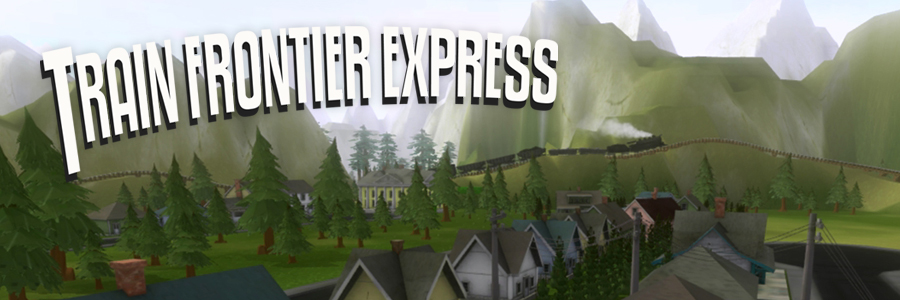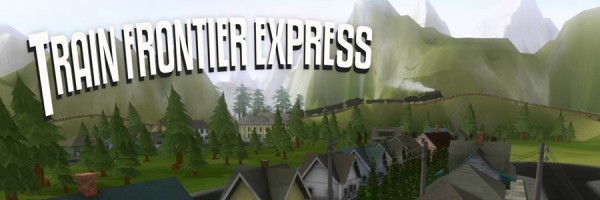Interview with Emoks and Eric, the conductors for Train Frontier Express
Tell us a little bit about yourself/company/team?
Emoks: We’re a duo; Eric has done all the coding and particles effects for the game, and I worked on the art. We’ve both worked on traditional games for the mainstream market, but had always wanted to try making something on our own and out-of-the-norm.
What made you decide to use the XBLIG platform for your game?
Emoks: It’s accessibility to the console market is what’s drawn me to XNA and XBLIG. Throughout the development process having that Xbox controller in my hands has been a good feeling (D-pad aside), knowing that console readiness was already there.
Eric: If you have a small game with less risk, then XBLIG can make sense as a platform and is a great way to get a game on a console quickly. I had reservations with XNA, since it’s limited to Microsoft platforms. It’s proven a blessing and a curse.
What was the biggest hurdle in getting this game finished?
Emoks: That’s a good question; I think just keeping the mindset that we can get it done even when progress slows and motivation wanes. The game really turned out to be much larger in scope than we anticipated and at times the mountain looked really high. But making progress and getting things in have really helped provide boosts–the first time I saw a pine tree that I could place was a huge moment; then the first time I saw a train moving on the tracks was another milestone. When we started putting out screenshots and slowly getting fans on Facebook who would ask about the game, it was like another layer of drive was added.
Eric: We go through phases of, “Let’s just release it,” to, “We could make it better.” I think stopping is the largest thing. Our wishlist for the game is gigantic, and we have a lot of pride as developers to keep adding and polishing. It’s a balancing act.
Do you have plans to continue developing games for the Xbox 360?
Emoks: We’ve got some plans to update Train Frontier, but nothing in stone beyond that.
Eric: Another XBLIG title is unlikely, beyond that, who knows?
How does it feel to know that your game was chosen by your peers and community?
Emoks: It was a great honor; the Indie Games Summer Uprising was a big push for us. At the bare minimum if we hadn’t gotten in it gave us some deadlines to hit just to be considered (and subsequently, to wrap it up!) I know we’re not the typical XBLIG, but had been hoping we would provide some of the diversity they were looking for, so when we were selected it was a great feeling. Dave and Kris have done a great job organizing (and wrangling) us and the event.
Eric: Our IGSU colleagues are really cool guys and we’re glad to be a part of it. We’ve definitely enjoyed the attention IGSU has brought us. We were really unsure how people would react, since XBL users aren’t exactly known for playing train sims, so battling obscurity was an issue.
What games directly influenced your game, both positive (wanted to mimic) and negative (things you didn’t wants players going through or feeling).
Emoks: I think the early sim games were an influence on the way one could get lost in the world they were creating. We wanted the builder mode to be as enjoyable as the actual riding, so we tried to make props placing and terrain sculpting as streamlined as possible. We still had to fit a lot onto the controller, but wanted to avoid a ton of menus for doing simple tasks–I think feedback from the fans will let us know how we did on that. We’re getting a fair amount of dads who are playing with their sons (as young as two) so we’re glad it’s accessible to both young and not-so-old.
Eric: Sim City, definitely. We looked at ModNation Racers and their builder and how they did zooming controls. Doing UI for a city and track builder is a lot harder than people realize, and we’ve seen diverging opinions on the controls. It seems like kids actually pick it up easier. Ironically, we hardly looked at other train sims, since they’re not known for accessibility. Art-wise, Emoks started out with this draft of a pop-art look, then also become inspired by a film called Open Season. After that, we looked at Team Fortress 2 and how they perfected their 50’s style.
How did you get into making games?
Eric: It was actually a childhood goal. There’s harsh realities to the game industry, so the idea kind of dissipated when I went into college. I only decided to focus on it again right after graduating, since I wanted to give it a shot while I was still young.
Emoks: A long journey through computer science, then art and then eventually making up my mind.
Do you feel your final product fully reflex the vision you had in your head?
Emoks: For the vision that was in my head at the beginning of the project, it exceeds it immensely. Way back in the beginning I think we envisioned something simpler, but kept layering on what we wanted to see (hence that mountain getting bigger) and then some bold decisions near the end, like Eric going for broke and adding multiplayer, really put it on a level that I had never anticipated.
Eric: Yes and no. Like Emoks said, the project is a lot larger than it was originally planned. We could’ve released the game many months ago and wrote it off, and we also could’ve held onto it for longer and added everything under the sun. But we all need to realize the game is three dollars. It’s a tremendous and great value at this point.


